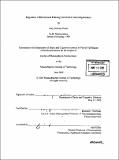| dc.contributor.advisor | Richard J. Wurtman. | en_US |
| dc.contributor.author | Pooler, Amy Melissa | en_US |
| dc.contributor.other | Massachusetts Institute of Technology. Dept. of Brain and Cognitive Sciences. | en_US |
| dc.date.accessioned | 2006-02-02T18:55:49Z | |
| dc.date.available | 2006-02-02T18:55:49Z | |
| dc.date.copyright | 2005 | en_US |
| dc.date.issued | 2005 | en_US |
| dc.identifier.uri | http://hdl.handle.net/1721.1/31177 | |
| dc.description | Thesis (Ph. D.)--Massachusetts Institute of Technology, Dept. of Brain and Cognitive Sciences, 2005. | en_US |
| dc.description | Includes bibliographical references. | en_US |
| dc.description.abstract | Alzheimer's disease (AD) is a neurodegenerative disorder characterized by cognitive decline and memory loss. Although much is known about how AD affects the brain, the cause of this disease remains elusive. Current AD treatments target symptoms of the disease but do not prevent or slow the underlying neurodegeneration. Therefore, research into the biochemical mechanisms of AD is necessary in order to develop a better understanding of how to treat it. Misprocessing of the amyloid precursor protein (APP) in the brains of AD patients leads to accumulation of the amyloidogenic peptide AD. A soluble APP fragment (APPS) is formed when APP is cleaved within the AP region, thereby preventing AP formation. Activation of 5-HT2A or 5-HT2c receptors has been shown to increase APPS secretion in vitro; therefore, we determined whether activation of these receptors might have a similar effect in vivo. We found that a 5-HT2A/2c agonist affected brain APP metabolism in guinea pigs by increasing CSF levels of APPS and, following chronic treatment, by decreasing levels of AP. Our data indicate that activation of brain 5-HT2c receptors may be useful for treating AD by reducing AP production. Traumatic brain injury is a risk factor for AD, although the reason is unknown. To explore this relationship, we examined the effect of the inflammatory mediator PGE2 on production of APP in cultured microglia. We found that PGE2 treatment stimulated APP overexpression and that this effect was likely mediated by the prostaglandin EP2 receptor and the cAMP signaling cascade. Therefore, EP2 receptor antagonists may constitute an additional target for prevention of AD following brain injury. | en_US |
| dc.description.abstract | (cont.) The neuropathology associated with AD includes neuritic dystrophy and degeneration. Therefore, restoration of neuritic growth and repair of phospolipid membranes may be important for treating AD. We found that treatment of NGF- differentiated PC 12 cells with the phospholipid precursor uridine enhanced neurite outgrowth by both enhancing phosphatide biosynthesis and by stimulating a G-protein receptor-coupled signaling pathway. Subsequently, we found that the HMG-CoA reductase inhibitor pravastatin enhanced neurite outgrowth in rat hippocampal neurons, not by affecting cholesterol synthesis, but by inhibition of isoprenoid formation. Stimulation of neurite growth by either uridine or statins may reduce AD risk by averting neuritic dystrophy and degeneration. However, further studies must be conducted to determine whether they are able to affect neuritic processes in vivo. | en_US |
| dc.description.statementofresponsibility | by Amy Melissa Pooler. | en_US |
| dc.format.extent | 110 p. | en_US |
| dc.format.extent | 5015331 bytes | |
| dc.format.extent | 5028685 bytes | |
| dc.format.mimetype | application/pdf | |
| dc.format.mimetype | application/pdf | |
| dc.language.iso | eng | en_US |
| dc.publisher | Massachusetts Institute of Technology | en_US |
| dc.rights | M.I.T. theses are protected by copyright. They may be viewed from this source for any purpose, but reproduction or distribution in any format is prohibited without written permission. See provided URL for inquiries about permission. | en_US |
| dc.rights.uri | http://dspace.mit.edu/handle/1721.1/7582 | |
| dc.subject | Brain and Cognitive Sciences. | en_US |
| dc.title | Regulation of biochemical pathways involved in neurodegeneration | en_US |
| dc.type | Thesis | en_US |
| dc.description.degree | Ph.D. | en_US |
| dc.contributor.department | Massachusetts Institute of Technology. Department of Brain and Cognitive Sciences | |
| dc.identifier.oclc | 61241682 | en_US |
